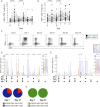Induction and regulation of T-cell immunity by the novel tuberculosis vaccine M72/AS01 in South African adults
- PMID: 23306546
- PMCID: PMC3778736
- DOI: 10.1164/rccm.201208-1385OC
Induction and regulation of T-cell immunity by the novel tuberculosis vaccine M72/AS01 in South African adults
Abstract
Rationale: Tuberculosis (TB) is a major cause of morbidity and mortality worldwide, thus there is an urgent need for novel TB vaccines.
Objectives: We investigated a novel TB vaccine candidate, M72/AS01, in a phase IIa trial of bacille Calmette-Guérin-vaccinated, HIV-uninfected, and Mycobacterium tuberculosis (Mtb)-infected and -uninfected adults in South Africa.
Methods: Two doses of M72/AS01 were administered to healthy adults, with and without latent Mtb infection. Participants were monitored for 7 months after the first dose; cytokine production profiles, cell cycling, and regulatory phenotypes of vaccine-induced T cells were measured by flow cytometry.
Measurements and main results: The vaccine had a clinically acceptable safety profile, and induced robust, long-lived M72-specific T-cell and antibody responses. M72-specific CD4 T cells produced multiple combinations of Th1 cytokines. Analysis of T-cell Ki67 expression showed that most vaccination-induced T cells did not express Th1 cytokines or IL-17; these cytokine-negative Ki67(+) T cells included subsets of CD4 T cells with regulatory phenotypes. PD-1, a negative regulator of activated T cells, was transiently expressed on M72-specific CD4 T cells after vaccination. Specific T-cell subsets were present at significantly higher frequencies after vaccination of Mtb-infected versus -uninfected participants.
Conclusions: M72/AS01 is clinically well tolerated in Mtb-infected and -uninfected adults, induces high frequencies of multifunctional T cells, and boosts distinct T-cell responses primed by natural Mtb infection. Moreover, these results provide important novel insights into how this immunity may be appropriately regulated after novel TB vaccination of Mtb-infected and -uninfected individuals.
Clinical trial registered with www.clinicaltrials.gov (NCT 00600782).
Figures






Similar articles
-
Improved CD4⁺ T cell responses to Mycobacterium tuberculosis in PPD-negative adults by M72/AS01 as compared to the M72/AS02 and Mtb72F/AS02 tuberculosis candidate vaccine formulations: a randomized trial.Vaccine. 2013 Apr 19;31(17):2196-206. doi: 10.1016/j.vaccine.2012.05.035. Epub 2012 May 27. Vaccine. 2013. PMID: 22643213 Clinical Trial.
-
Safety and immunogenicity of the M72/AS01 candidate tuberculosis vaccine in HIV-infected adults on combination antiretroviral therapy: a phase I/II, randomized trial.AIDS. 2014 Jul 31;28(12):1769-81. doi: 10.1097/QAD.0000000000000343. AIDS. 2014. PMID: 24911353 Clinical Trial.
-
Safety and immunogenicity of candidate vaccine M72/AS01E in adolescents in a TB endemic setting.Vaccine. 2015 Jul 31;33(32):4025-34. doi: 10.1016/j.vaccine.2015.05.088. Epub 2015 Jun 10. Vaccine. 2015. PMID: 26072017 Free PMC article. Clinical Trial.
-
Functional Signatures of Human CD4 and CD8 T Cell Responses to Mycobacterium tuberculosis.Front Immunol. 2014 Apr 22;5:180. doi: 10.3389/fimmu.2014.00180. eCollection 2014. Front Immunol. 2014. PMID: 24795723 Free PMC article. Review.
-
Immunogenicity and Safety of the M72/AS01E Candidate Vaccine Against Tuberculosis: A Meta-Analysis.Front Immunol. 2019 Sep 3;10:2089. doi: 10.3389/fimmu.2019.02089. eCollection 2019. Front Immunol. 2019. PMID: 31552037 Free PMC article. Review.
Cited by
-
Vaccines for TB: Lessons from the Past Translating into Future Potentials.J Immunol Res. 2015;2015:916780. doi: 10.1155/2015/916780. Epub 2015 Jun 3. J Immunol Res. 2015. PMID: 26146643 Free PMC article. Review.
-
It Takes a Village: The Multifaceted Immune Response to Mycobacterium tuberculosis Infection and Vaccine-Induced Immunity.Front Immunol. 2022 Mar 10;13:840225. doi: 10.3389/fimmu.2022.840225. eCollection 2022. Front Immunol. 2022. PMID: 35359957 Free PMC article. Review.
-
Clinical Development of New TB Vaccines: Recent Advances and Next Steps.Front Microbiol. 2020 Jan 30;10:3154. doi: 10.3389/fmicb.2019.03154. eCollection 2019. Front Microbiol. 2020. PMID: 32082273 Free PMC article. Review.
-
Tuberculosis vaccine development: from classic to clinical candidates.Eur J Clin Microbiol Infect Dis. 2020 Aug;39(8):1405-1425. doi: 10.1007/s10096-020-03843-6. Epub 2020 Feb 15. Eur J Clin Microbiol Infect Dis. 2020. PMID: 32060754 Free PMC article. Review.
-
Key recent advances in TB vaccine development and understanding of protective immune responses against Mycobacterium tuberculosis.Semin Immunol. 2020 Aug;50:101431. doi: 10.1016/j.smim.2020.101431. Epub 2020 Dec 2. Semin Immunol. 2020. PMID: 33279383 Free PMC article. Review.
References
-
- World Health OrganizationGlobal tuberculosis control 2011 [accessed 2011 Dec 6]. Available from: http://www.who.int/tb/publications/global_report/en/index.html
-
- Rodrigues LC, Diwan VK, Wheeler JG. Protective effect of BCG against tuberculous meningitis and miliary tuberculosis: a meta-analysis. Int J Epidemiol. 1993;22:1154–1158. - PubMed
-
- Colditz GA, Brewer TF, Berkey CS, Wilson ME, Burdick E, Fineberg HV, Mosteller F. Efficacy of BCG vaccine in the prevention of tuberculosis: meta-analysis of the published literature. JAMA. 1994;271:698–702. - PubMed
-
- Rappuoli R, Aderem A. A 2020 vision for vaccines against HIV, tuberculosis and malaria. Nature. 2011;473:463–469. - PubMed
Publication types
MeSH terms
Substances
Grants and funding
LinkOut - more resources
Full Text Sources
Other Literature Sources
Research Materials

